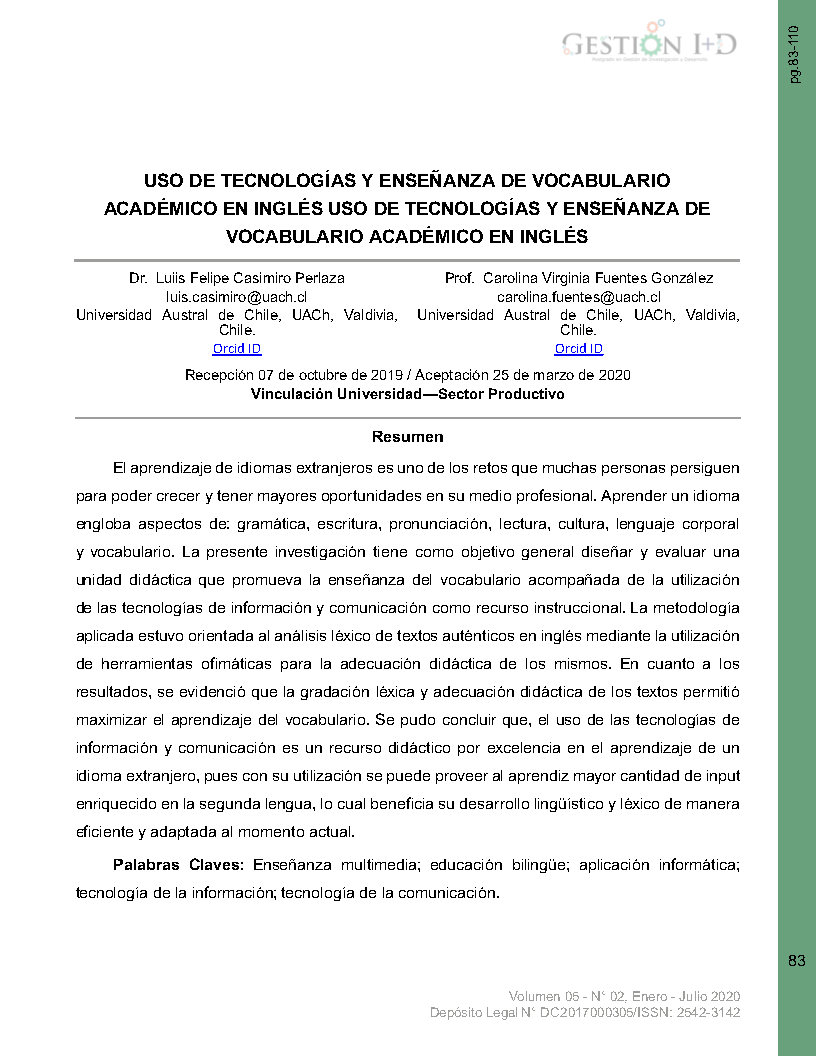Uso de tecnologías y enseñanza de vocabulario académico en inglés
Palabras clave:
Enseñanza multimedia, educación bilingüe, aplicación informática, tecnología de la información, tecnología de la comunicaciónResumen
El aprendizaje de idiomas extranjeros es uno de los retos que muchas personas persiguen para poder crecer y tener mayores oportunidades en su medio profesional. Aprender un idioma engloba aspectos de: gramática, escritura, pronunciación, lectura, cultura, lenguaje corporal y vocabulario. La presente investigación tiene como objetivo general diseñar y evaluar una unidad didáctica que promueva la enseñanza del vocabulario acompañada de la utilización de las tecnologías de información y comunicación como recurso instruccional. La metodología aplicada estuvo orientada al análisis léxico de textos auténticos en inglés mediante la utilización de herramientas ofimáticas para la adecuación didáctica de los mismos. En cuanto a los resultados, se evidenció que la gradación léxica y adecuación didáctica de los textos permitió maximizar el aprendizaje del vocabulario. Se pudo concluir que, el uso de las tecnologías de información y comunicación es un recurso didáctico por excelencia en el aprendizaje de un idioma extranjero, pues con su utilización se puede proveer al aprendiz mayor cantidad de input enriquecido en la segunda lengua, lo cual beneficia su desarrollo lingüístico y léxico de manera eficiente y adaptada al momento actual
Descargas
Citas
Alderson, J. (1984). Reading in a foreign language: A reading problem or a language problem? In J. Alderson & A. Urquhart (Eds.), Reading in a foreign language (pp. 1–27). London: Longman.
Beck, I., Perfetti, C., & McKeown, M. (1982). Effects of text construction and instructional procedures for teaching word meanings on comprehension and recall. Journal of Educational Psychology, 74, 506–521.
Chambers, A., & Bax, S. (2006). Making CALL work: Towards normalization. System: An International Journal of Educational Technology and Applied Linguistics, V. 34 N. 4 p 465-479.
Chapelle, C. A. (2003). Technology and second language learning: Expanding methods and agenda. Consultado en https://lib.dr.iastate.edu/cgi/viewcontent.cgi? article=1039 &context= engl_pubs
Chapelle, C. A. (2010). Challenges in evaluation of innovation: Observations from technology research. International Journal of Innovation in Language Learning and Teaching, Vol. 1 No. 1.
Chapelle, C.A. (2010). The spread of computer-assisted language learning. Language Teaching, 43 (1), 66-74.
Chen, C. F. E. (2008). The development of email literacy: From writing to peers to writing to authority figures. Language Learning & Technology. University of Hawaii National Foreign Language Resource Center.
Consejo de Europa (2002), Marco común europeo de referencia para las lenguas: aprendizaje, enseñanza, evaluación. Madrid, MECD y Anaya.
Davis, F. (1944). Fundamental factors of comprehension in reading. Psychometrika, 9(3), 185–197.
Davis, P. and Fraenkel, A. (2003). The language in English teaching. London: Richmond.
Davies, G., & Hewer, S. (2012). Introduction to new technologies and how they can contribute to language learning and teaching. Module 1.1. In G. Davies (Ed.), Information and communications technology for language teachers (ICT4LT). Slough: Thames Valley University.
Dudley-Evans, T. 2001. “Team-teaching in EAP: Changes and adaptations in the Birmingham approach”. Research Perspectives on English for Academic Purposes. Eds J. Flowerdew y M. Peacock. Cambridge: Cambridge University Press. 225-238.
Eren. M. (2015). Vocabulary learning on learnercreated content by using web 2.0 tools. Contemporary Educational Technology, 5(4), 281-300.
Fitzpatrick, J. Saners, J. and Worthen, B. R. (2004). Program evaluation: Alternatives, approaches, and practical guidelines (3rd ed.). Boston: Pearson Education Inc.
Folse, K. (2004) Vocabulary Myths. USA: University of Michigan Press.
Garrett, N. (2009). Computer-Assisted Language Learning Trends and Issues Revisited: Integrating Innovation. The Modern Language Journal, 93, 719-740.
Gençlter, B. (2015). How does technology affect language learning process at an early age? Procedia - Social and Behavioral Sciences, 199(2015), 311 – 316. doi: 10.1016/j.sbspro.2015.07.552
Hismanoğlu, M. (2011). The integration of information and communication technology into current ELT coursebooks: a critical analysis. Procedia - Social and Behavioral Sciences, 15, 37–45. https://doi.org/10.1016/j.sbspro.2011.03.048
Huckin, N.T., & Bloch, J. (1993). Strategies for Inferring Word Meanings in Context: A Cognitive Model. Second Language Reading and Vocabulary Learning, ed. by T. Huckin, M. Haynes, J. Coady, (pp. 87-107), NJ: Ablex, Norwood.
Hurtado, J. (2010). El proyecto de investigación. Comprensión holística de la metodología y la investigación. 6ª edición. Caracas, Venezuela: Ediciones Quirón.
Hutchinson, T., & Waters, A. (1987). English for specific purposes: A learning-centred approach. Cambridge: Cambridge University Press.
James, M. (1996). Improving second language reading comprehension: A computer-assisted vocabulary development approach. Unpublished doctoral dissertation, University of Hawaii, Manoa.
Jung, S. (2006). Information and Communication Technology Use and Skills (ICTUS) for learning English. Doctoral dissertation, University of Maryland.
Kameenui, E., Carnine, D., & Freschi, R. (1982). Effects of text construction and instructional procedures for teaching word meanings on comprehension and recall. Reading Research Quarterly, 17, 367–388.
Khany, R. & Khosravian, F. (2014). Iranian EFL learners' vocabulary development through Wikipedia. English Language teaching, 7(7). 57- 67.
Krashen, S. (1982) Principles and Practice in Second Language Acquisition. Oxford: Pergamon Press.
Krashen, S. (1985) The imput hypothesis: Issues and implications. Laredo Publishing Co: California.
Kumar, C. P. (2013). The Eclectic Method: Theory and Its Application to the Learning of English. International Journal of Scientific and Research Publications, 3(6):ISSN 2250-3553.
Kumaravadivelu, B. (1994). The postmethod condition: Emerging strategies for second/ foreign language teaching. TESOL Quarterly, 28(1), 27-48. Recuperado de: http://bkumaravadivelu.com/articles%20in%20pdfs/1994%20Kumaravadivelu%20Postmethod%20Condition.pdf.
Larsen- Freeman, D., & Anderson, M. (2011). Techniques and principles in language teaching. Oxford: OUP.
Laufer, B. (1992). How much lexis is necessary for reading comprehension? In P. Arnaud & H. Bejoint (Eds.), Vocabulary and applied linguistics (pp. 126–131). London: Macmillan Academic and Professional Limited.
Laufer, B. (1997). The lexical plight in second language reading: Words you don’t know, words you think you know, and words you can’t guess. In J. Coady & T. Huckin (Eds.), Second language vocabulary acquisition (pp. 20–34). Cambridge: Cambridge University Press.
Lee, J., & Bonk, C. J. (2016). Social network analysis of peer relationships and online interactions in a blended class using blogs. The Internet and Higher Education, 28, 35–44. https://doi.org/10.1016/j.iheduc.2015.09.001
Lenhart, A., Kahne, J., Middaugh, E., Macgill, A. R., Evans, C., & Vitak, J. (2008). Teens, video games, and civics: Teens’ gaming experiences are diverse and include significant social interaction and civic engagement. Pew Internet & American Life Project. Consultado en Pew Internet & American Life Project website: http://www.pewinternet.org/ Reports/2008/Teens-Video-Games-and-Civics.aspx
Lewis, M. (1993) The Lexical Approach. London: Language Teaching Publications.
Lewis, M. (1997) Implementing Lexical Approach. London: Language Teaching Publications.
Lewis, M. (2000) Teaching Collocation. Further development in the Lexical Approach. London: Language Teaching Publications.
Meara, P. (1980). Vocabulary acquisition: A neglected aspect of language learning. Language Teaching and Linguistics Abstracts. 221-246.
Mostmans, L., Vleugels, C., & Bannier, S. (2012). Raise your hands or hands-on? The role of computer-supported collaborative learning in stimulating intercreativity in education. Journal of Educational Technology & Society, 15(4), 104.
Mullamaa, K. (2010). ICT in Language Learning – Benefits and Methodological Implications. International Education Studies, 3 (1), 38-44.
Nation, P., & Coady, J. (1988). Vocabulary and reading. In R. Carter & M. McCarthy (Eds.), Vocabulary learning and teaching (pp. 97–110). London: Longman.
Nation, I. S. P. (1990) Teaching and Learning vocabulary. New York: Newbury House.
Onrubia, J. (2007). Las tecnologías de la información y la comunicación como instrumento de apoyo a la innovación de la docencia universitaria. Revista Interuniversitaria de Formación del Profesorado. 21(1): 21-36.
Prinzessinnadia (2013). ICT In English Language Teaching and Learning. Consultado en febrero de 2020 en https://prinzessinnadia.wordpress.com/2013/02/01/ict-in-englishlanguage-teaching-and-learning/
Sadikin. I.S. (2016). The use of web quest for teaching English vocabulary in an EFL young learner context. ICTTE, 1(1).
Sánchez , J. (2003). Integración curricular de las TIC’s: conceptos e ideas. [artículo en línea]. Consultado en. Línea, febrero de 2020. http://www.c5.cl/mici/pag/papers/inegr_curr.pdf
Schmid, E. C. (2010). Bringing Technology into the Classroom. ELT Journal, 65(1), 89– 91.
Strevens, P. 1988. “ESP after twenty-years: a re-appraisal”. ESP: State of the Art. Ed. M. Tickoo. Singapore: SEAMEO Regional Language Centre. 1-13.
Tinio, V. L. (2002). Survey of Information & Communication Technology Utilization in Philippine Public High Schools. Consultado en febrero de 2020.
Universidad Pedagógica Experimental Libertador (2011). “Manual de Trabajos de Grado, de Especialización, Maestría y Tesis Doctorales”. Caracas: Venezuela.
Universidad Santa María (2017). Programa de Inglés Instrumental I. Centro de Idiomas. Caracas.
Yunus, M.MD., Hashim, H., Embi, M.A., & Lubis, M.A. (2010) The utilization of ICT in the teaching and learning of English: ‘TELL ME MORE’. Procedia Social and Behavioral Sciences, 9, 686-691




